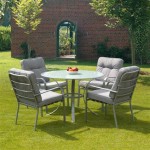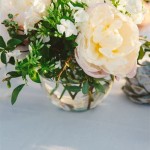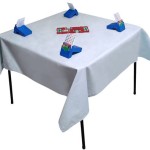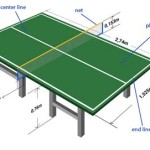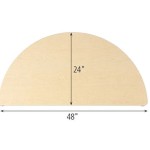Round Side Table Decor Ideas: Enhancing Functionality and Style
Round side tables are versatile pieces of furniture that seamlessly blend functionality and aesthetic appeal within a variety of interior spaces. Their compact footprint and rounded edges make them ideal for placement in living rooms, bedrooms, hallways, or even bathrooms, offering a convenient surface for lamps, books, beverages, or decorative objects. Decorating a round side table effectively involves a thoughtful combination of practicality and visual interest, ensuring it complements the overall design scheme of the room while serving its intended purpose.
This article explores various round side table decor ideas, providing insights into selecting appropriate items, arranging them artfully, and achieving a harmonious balance between form and function. The focus will be on creating a cohesive and visually appealing display that enhances the room's ambiance and reflects personal style.
Understanding the Table's Role and Context
Before embarking on the decoration process, it is crucial to understand the role the round side table plays within its specific environment. Consider its location, its proximity to other furniture pieces, and the overall style of the room. A side table placed next to a sofa in the living room will likely require a different decorative approach than one positioned beside a bed in the bedroom. The desired function of the table – whether it serves primarily as a surface for reading materials, a display area for decorative objects, or a resting place for beverages – should also influence the selection and arrangement of items.
In a living room, the side table might serve as an anchor point for a reading nook, housing a lamp, a stack of books, and perhaps a small plant. In a bedroom, it could function as a nightstand, holding a lamp, a book, and personal items. In a hallway, a round side table can act as a welcoming display surface for a vase of flowers, a decorative bowl, or a collection of framed photographs. Identifying the primary function of the table will help guide the selection of appropriate and practical decor elements.
The style of the room is another critical factor to consider. A modern, minimalist room will benefit from a sparsely decorated side table featuring clean lines and simple geometric shapes. A bohemian-inspired room might embrace a more eclectic and layered approach, incorporating textured fabrics, vintage finds, and natural elements. A traditional room could call for classic accessories such as a porcelain lamp, a silver tray, and a stack of leather-bound books.
Considering the surrounding furniture is equally crucial. The side table should complement the style and scale of nearby furniture, creating a sense of visual harmony. For example, a small, delicate side table might look out of place next to a large, oversized sofa. Conversely, a bulky side table could overwhelm a small, dainty armchair. Pay attention to the colors, materials, and textures of the surrounding furniture to ensure a cohesive and balanced aesthetic.
Key Elements of Round Side Table Decor
Several key elements contribute to a well-decorated round side table. These elements include lighting, books and magazines, decorative objects, plants and flowers, and trays or coasters. The successful combination and arrangement of these elements will result in a functional and visually appealing display.
Lighting: A lamp is often a primary element on a round side table, providing both task lighting and ambient illumination. The style of the lamp should complement the overall design of the room. A sleek, modern lamp with a minimalist shade might suit a contemporary space, while a more traditional lamp with an ornate base and a fabric shade could enhance a classic setting. Consider the height of the lamp in relation to the surrounding furniture. The lamp should be tall enough to provide adequate lighting for reading or other tasks, but not so tall that it overwhelms the table.
Books and Magazines: Books and magazines add a sense of intellectual curiosity and visual interest to a side table display. Choose books that reflect personal interests or complement the room's décor. Arrange them in stacks of varying heights to create visual dynamism. Consider using decorative bookends to add a touch of personality. Magazines can be neatly stacked or displayed in a stylish magazine holder. Coffee table books with visually appealing covers are excellent choices for adding a touch of sophistication.
Decorative Objects: Decorative objects such as vases, sculptures, bowls, and trays add personality and visual interest to a round side table. Choose objects that reflect personal style and complement the room's décor. Consider using objects of varying heights and shapes to create visual dynamism. A collection of small objects can be grouped together to create a focal point. A decorative tray can be used to corral small items and prevent clutter. Avoid overcrowding the table with too many objects, as this can create a cluttered and disorganized appearance.
Plants and Flowers: Plants and flowers bring life and freshness to a side table display. Choose plants that are appropriate for the lighting conditions in the room. A small potted plant or a vase of fresh flowers can add a touch of nature and color to the space. Consider using a stylish planter or vase to enhance the overall aesthetic. Faux plants are also an option for those who prefer low-maintenance greenery. Be mindful of the size of the plant or flowers in relation to the table. A large, overgrown plant could overwhelm a small side table.
Trays and Coasters: Trays and coasters are practical accessories that can also add to the overall aesthetic of a round side table. A decorative tray can be used to corral small items such as keys, remotes, or jewelry. Coasters protect the table's surface from scratches and water rings. Choose trays and coasters that complement the style of the room. A silver tray might suit a traditional setting, while a wooden tray could enhance a rustic or farmhouse-style space. Consider using coasters with interesting patterns or textures to add a touch of visual interest.
Achieving Balance and Harmony
Creating a balanced and harmonious arrangement on a round side table involves careful consideration of proportion, scale, and color. The goal is to create a visually pleasing display that complements the room's décor without feeling cluttered or overwhelming.
Proportion and Scale: The size and proportion of the items on the side table should be appropriate for the size of the table itself. Avoid placing items that are too large or too small in relation to the table. A large lamp on a small table can look unbalanced, while a tiny object on a large table can appear insignificant. Aim for a sense of visual equilibrium, ensuring that the items are appropriately scaled to the table and to each other.
Color Palette: The colors of the items on the side table should complement the overall color scheme of the room. Consider using a consistent color palette or incorporating accent colors to add visual interest. A monochromatic color scheme can create a sense of sophistication and elegance, while a contrasting color scheme can add a pop of energy and vibrancy. Avoid using too many colors, as this can create a chaotic and disorganized appearance. A well-chosen color palette will create a cohesive and visually appealing display.
Layering and Texture: Layering and texture add depth and visual interest to a side table display. Combine items of varying heights and textures to create a dynamic and engaging arrangement. A stack of books topped with a small decorative object or a tray with a textured surface can add layers of visual interest. Consider incorporating natural textures such as wood, stone, or woven materials to add warmth and character to the display. Mixing smooth and rough textures can also create a visually appealing contrast.
Negative Space: Negative space, or the empty space around the items on the table, is just as important as the items themselves. Avoid overcrowding the table with too many objects, as this can create a cluttered and overwhelming appearance. Allow for some empty space around the items to allow them to breathe and to create a sense of visual balance. Negative space can also help to highlight the individual items and to draw attention to their unique features.
By carefully considering these key elements and principles, it is possible to transform a simple round side table into a functional and visually appealing focal point within any room. The key is to embrace creativity, experiment with different arrangements, and ultimately create a display that reflects personal style and enhances the overall ambiance of the space.

Style A Round Coffee The Easy Way Stonegable

How To Style A Round Coffee Table Studio Mcgee Decor Living Room

How To Create A Beautiful Family Room Side Table Decor Home Round

33 Trendy Ways To Arrange Coffee Table Decor Round Arrangements Side

Style A Round Coffee The Easy Way Stonegable

Driven By Decor Living Room Corner

Diy Round Side Table Makeover My Creative Days

51 Round Side Tables With Designer Decorative Appeal

Style A Round Coffee The Easy Way Stonegable

Home Decor 101 How To Decorate End Tables The Turquoise

